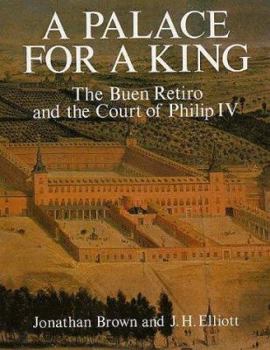A Palace for a King: The Buen Retiro and the Court of Philip IV
Select Format
Select Condition 
Book Overview
The Buen Retiro, a royal retreat and pleasure palace, was built for Philip IV on the outskirts of Madrid in the 1630s. With its superb display of paintings by Velazquez and other contemporary artists,... This description may be from another edition of this product.
Format:Paperback
Language:English
ISBN:0300036213
ISBN13:9780300036213
Release Date:September 1986
Publisher:Yale University Press
Length:296 Pages
Weight:2.10 lbs.
Dimensions:0.8" x 7.8" x 10.1"
Customer Reviews
1 rating
How can a book involving Philip IV *not* get five stars?
Published by Thriftbooks.com User , 24 years ago
On March 31, 1621, Philip III, third Habsburg ruler of Spain, met a premature death, reportedly clutching in panic at the same crucifix his father and grandfather had held on their deathbeds generations before. His son and heir, the sixteen-year-old Philip IV, succeeded to what is now known collectively as the Spanish Empire - a vast conglomeration of lands and people whose progressive decline as a political entity has long remained a basic assumption amongst twentieth century historians and yet whose cultural vitality has given its period the title of "The Golden Age of Spanish Art." The accession of Philip IV seemed to inaugurate a new era of reform after the previous regime's mindless inactivity and self-interested grandee domination. As the contemporary playwright Tirso de Molina remarked, "New architects acceded with the new king."This premise serves as the central metaphor in A Palace for a King. Elliott, a historian, and Brown, an art historian, examine both the literal and political architecture of the reign, charting the complicated, often surprising interrelation between art and politics. The palace of the title is the Buen Retiro - an intended recreational center built for Philip IV with astonishing speed during the years 1630-33, left largely in neglect after the 1640's, and finally decimated by French and English troops during the Napoleonic wars. In reconstructing the circumstances surrounding its construction and initial occupation, Brown and Elliott attempt to furnish the reader with a "total" history of the Spanish Habsburg court during its penultimate representative's first twenty years of rule. The scope of the book is immense. In a prose that is precise and elegant, if at times monotonous, it describes the political and economic issues of the day as well as the relationship between the continuously vacillating king and his powerful minister, the Count-Duke of Olivares, who until 1643 held the true control over Spanish government. It then goes on to analyze the palace of the Buen Retiro itself, exploring the process of palace-building and the symbolism of the palace as a repository of the values of the ruling class. Simultaneously, it looks at Spanish baroque painting, theater, and architecture and their inextricable connection to the court at Madrid, which, itself, was in so many ways like a giant theater. Elliott's inquiry and interpretation of the troubles besetting the institution that was then called the monarquía española and of the role played by Olivares makes for particularly rewarding reading.The book appears to be extremely well-researched and provides an abundance of evidence from primary sources as varied as confidential memoranda, secret expense accounts and drawings of architectural plans; the endnotes alone constitute twenty of its almost three hundred pages. However, it is its very wealth of references and information that also lies at the core of its greatest weakness. To




